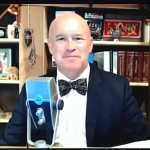I saw this short animation, showing the spread and the speciation of the languages of the Indo-European linguistic group when it was released exactly a year ago but I somehow forgot to share it at the time. I think it’s fascinating. You see how all of the Germanic and Romance languages grew out of an earlier Balto-Slavic language and how Sanskrit and Hindi descended from an ancient Indo-Iranian language, making Old Persian older than Sanskrit.
This animation is based on a study conducted at the University of Auckland, New Zealand, which challenges the long-held view that Indo-European languages originated from a single language that sprang up somewhere northeast of the Black Sea.
The Indo-European linguistic group is the largest in the world, constituting 46% of all natively-spoken languages, which include English and all of the Germanic languages, all of the Romance languages, the Slavic languages, Greek, Armenian, Farsi, Urdu, Hindi and the many lesser-known languages related to these.
You may be surprised to know that the most widely spoken Indo-European languages by native speakers are 1) Spanish, 2) English, 3) Hindustani (Hindi and Urdu), 4) Portuguese, 5) Bengali, 6) Russian, 7) Persian and 8) Punjabi, each with over 100 million speakers.
Kiwi Evolutionary Biologist, Dr. Quentin Atkinson arrived at his conclusion that the original proto-Indo-European language originated in the land now known as Turkey, based on linguistic drift. It didn’t work, when he tried to make the point of origin north of the Black Sea.
Ironically, the language spoken in Turkey today, written with a Roman alphabet and spoken by a people who do not resemble East Asians comes from a linguistic group, which originated in the area in and around modern-day Mongolia.
English is similarly the native language of tens of millions of people who are not from England.
The Turkish language was brought to Anatolia by migrations of Turkic-speaking peoples between the 6th and 11th centuries, during which time the region made a transition from being predominantly Greek-speaking and Christian into one that is Turkish-speaking and Muslim.
Then, after millennia of being colonized successively by the empires of the Hittites, Greeks, Romans and Persians, Turkey proceeded to itself become the center of the Ottoman Empire from 1299 to 1922 CE, during which time it was one of the world’s greatest centers of wealth, military and cultural power, controlling most of the lands around Mediterranean Sea until the end of World War I.











“Balto-Slavic” is nothing but an old misconception, that no-one knows if ever existed.
Which makes this conceptualized model a blunt flaw.
Yes. Balto-Slavic is a theoretical proto-linguistic group, as well as a proto-ethnic group.
I’m no linguistic authority for sure, but I noticed right off that this seems to forget at least several things such as the universality of Greek after Alex conquered most of the known world; Hebrew and Aramaic, neither of which have representation here.
Just a side note here. Isaac Mozeson published an interesting book The World, subtitled The Dictionary That Reveals The Hebrew Source of English. I think it’s out of print, but there may be used somewhere if anyone is interested. It’s pretty compelling.
Alexander ruled at the very end of the Greek Empire. His rule was brief and it apparently didn’t have a strong linguistic impact on the everyday people he conquered, despite the importance of Ancient Greek as a scholarly language, spoken as a second language by a small academic elite. Hebrew and Aramaic are of the Semitic linguistic group, which is why they’re not shown in this animation. Arabic is by far the most widely-spoken Semitic language, which makes the term “anti-Semitic” somewhat problematic, to say the least. There was a big movement of “British Israelism” during the 19th century, which was and remains particularly strong in Australia. The idea was to “prove” that the world-dominating British were also the “Chosen” people of the Bible. There is no linguistic basis for British Israelism. There is however potential evidence for a possible single language which preceded these linguistic groups, à la the Tower of Babel. Here’s an interesting clip about “15,000 Year Old Words We Still Use”: https://www.youtube.com/watch?v=rLswn9bIobU.
I yield to your superior knowledge on this, but Semitic language is not of equal worth for consideration? I don’t think so. Mozeson went to considerable lengths to prove linkage between not only the English language and Hebrew, but to so many languages that he argued for Hebrew as the original language before Babel.
Like I said, I’m no expert, just sharing Mozeson’s view.
BritAm just went too far beyond the evidences which are considerable and real. This is not uncommon when “experts” exchange their objectivity for subjectivity. On the other hand experts can become so ossified in the accepted orthodoxy they can’t see over the top of the box they are in. As example, Hebrews were running around all over the place during and after their sojourn in Egypt and they were intermarrying, so racial purity and land rights are mostly a myth maintained by Jews and Christ-claimers.
All I can say is ” they went away black and came back white”. What a bunch of fakes we got in the UK and in Palestine today.
I wonder if this relates to yesterdays video about the Egyptian discovery in central Turkey. Also, isn’t Mt. Ararat near there. The place where Noah’s Ark is reputed to have come to rest.
Ararat is in eastern Turkey, but still.
The actual location of the ark is in the Ararat mountain range. The reason why they cannot find it on Mt Ararat is that it was likely never there. Researchers are coming to that conclusion.
Yes. Yesterday’s video made me think of Turkey and how little of its incredibly rich history is known by Americans.
I should have been more specific, but since I cannot possibly recall everything on demand, I generalized. “And the ark went and rested on the top of Lubar, one of the mountains of Ararat.” Jubilees 5:28 This narrows the location down a lot.
This also shows the pattern of aggression. One should not suppose that there were no people in neighboring regions or that they had no language. People are obliged to learn the language of their subjugators. Brazil is a very clear relatively modern example.
Yes, this map of Europe absolutely shows a pattern of conquest toward the end but earlier, according to Dr. Atkinson, it shows the spread of a farming culture, which replaced a previous hunter-gatherer culture. Examples of conquest are the Romance languages which all descend from Latin, due to the expansion of the Roman Empire. There are also patterns of cultural dominance, which arise especially in the British Isles, where English replaced the Celtic languages fairly recently. In the New World, we see more of the subjugation you’re talking about. Your comments about Brazil would probably be more accurately said about Mexico, Central America and northeastern South America, where indigenous populations were high at the time of Spanish conquest and continue to be high. Brazil’s Amerindian population was not as large or as dense as say, Mexico’s. Unlike Mexico, Brazil is ethnically 40% mixed African heritage and 20% Italian. Afro-Brazilians were subjugated by the Portuguese colonizers but the Italian and other European, Asian and Middle Eastern immigrants to Brazil, most of whom arrived after the First World War (many Christian Syrio-Lebanese began arriving after the collapse of the Ottoman Empire and were called “Turks” by the Brazilians because they had Turkish passports), they weren’t “subjugated” into speaking Portuguese, the same way immigrants to the US weren’t subjugated into speaking English (viz https://en.wikipedia.org/wiki/São_Paulo). It was about conforming to the language of the new home country. Gisele Bündchen is an 8th generation German-Brazilian. Germans have been immigrating to Brazil since the early 1700s, like they have to the US. Germans are today the largest ethnic group in the US. Until recently, Irish was the largest ethnic group in the US but a huge wave of Germans arrived in the US after the collapse of the Soviet Union. Germans were the second largest group of immigrants to the US during the decade of the 2000s, after Mexicans. German almost became the national language of the US because there were so many German-Americans and the Founding Fathers seriously contemplated making a very strong linguistic break from England during the American Revolution. There are many, many factors in play, in the spread and influence of languages.